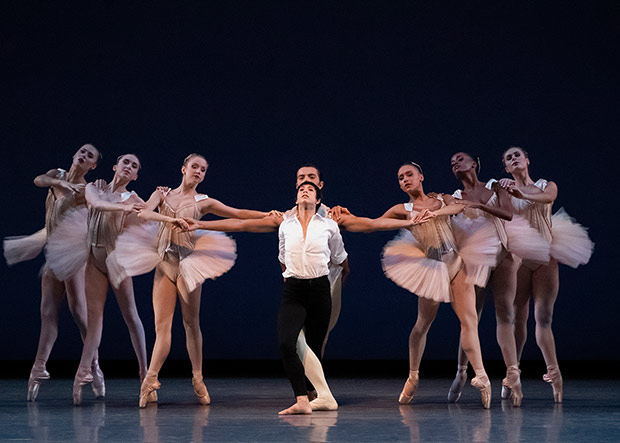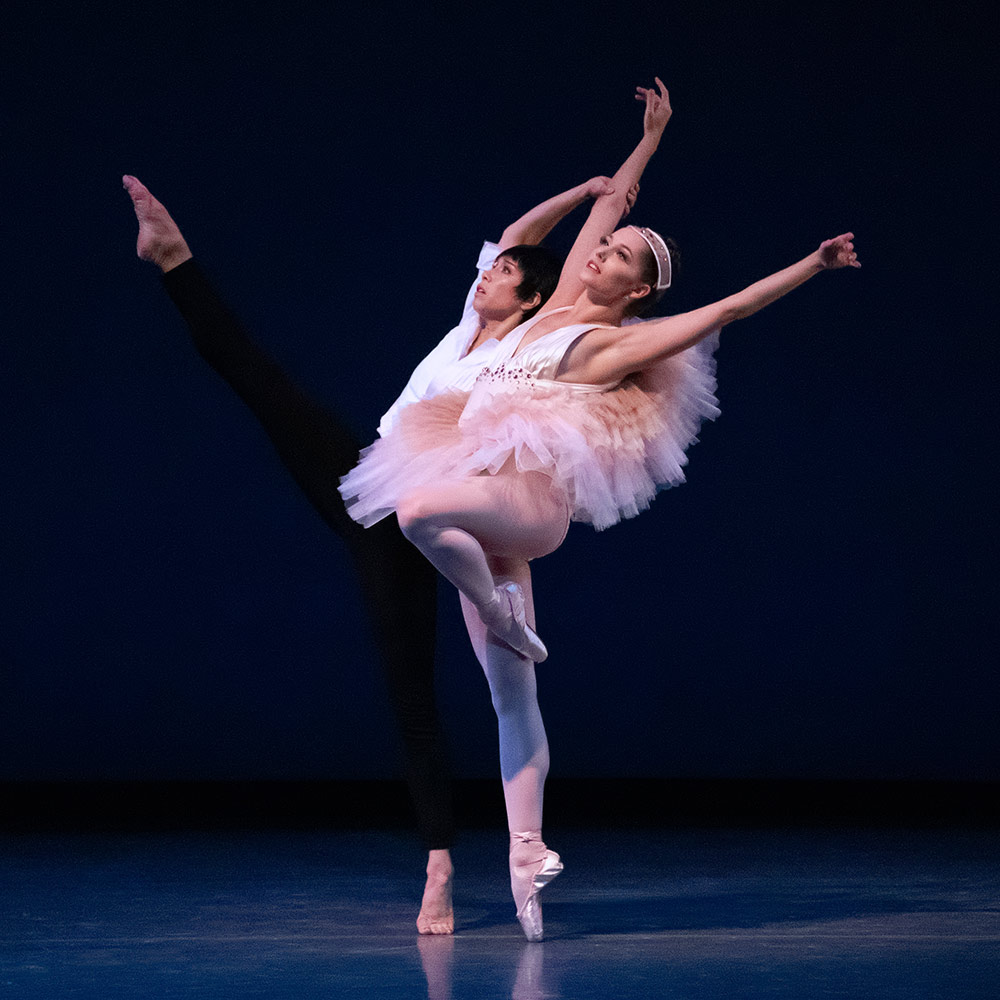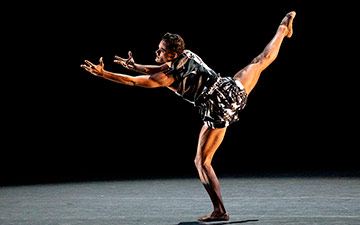
© Erin Baiano. (Click image for larger version)
New York City Ballet
Fall Fashion Gala: The Shaded Line, Lineage, Symphony in C
★★★✰✰
New York, David H. Koch Theater
27 September 2019
www.nycballet.com
davidhkochtheater.com
Far from the Madding Crowd
The theme of New York City Ballet’s yearly fall gala is the crossover between fashion and ballet. Each season, the new works being unveiled are dressed by a famous couturier – this year, Anna Sui and Zac Posen. The track record is mixed: I remember dresses that made the dancers look like lampshades and a shoulder-strap that came undone at an inopportune moment. Nothing egregious happened this year; in fact, I would say that for once the costumes actually enhanced the dances.
Zac Posen’s reimagined tutus for Lauren Lovette’s The Shaded Line – her third work for the company – were intriguing. If I were to name the one thing I dislike most about tutus it is the way they often fail to cover the dancers’ derrieres, making them look like prepubescent girl-dolls. Posen took this idea as his starting point, creating tutus that gathered in the rear, intentionally revealing the dancers’ back sides, and the white leotard beneath. One of them was pulled up so high that the edges of the tulle evoked wings. The effect is witty and strange.

© Erin Baiano. (Click image for larger version)
The significance of the modified tutu also becomes one of the themes of Lovette’s ballet, which seems to comment on the fantastic weirdness of balletic convention and how it both attracts and torments the ballet’s outsider-heroine, the soloist Georgina Pazcoguin. Pazcoguin has never quite fit into the City Ballet mold; she’s an emotive, bold dancer who excels in theatrical pieces like West Side Story Suite and NY Export: Opus Jazz. She has danced on Broadway, in Cats, and in the recent tv series about Gwen Verdon and Bob Fosse. One gets the sense she’d like to be a star, but has never quite gotten her due. In Lovette’s ballet, she alone is dressed in chic street clothes: slim black trousers, a white shirt, gamine black wig, and black pointe shoes. The music, by Tan Dun (a violin concerto entitled Fire Ritual), tells its own story, with clashing percussion and sonorities sometimes reminiscent of Peking Opera. The dancers contribute to the musical ambiance with hisses and humming; Pazcoguin, too, breaks out in yelping vocal phrases.
At first, the other dancers appear to be emanations of Pazcoguin’s mind: they hover and float in the half-light, backs turned, butts exposed, like strange, feathered creatures. Pazcoguin rages at them, or is lifted and engulfed by the group. Having removed her pointe shoes, she is visited by three “spirits,” two female, one male. She partners one of the women, taking a dominant, more conventionally masculine role. Taylor Stanley, sheathed in a corset with winglets, approaches her, slithery and undulating, like a glinting creature from another world. He eventually hands the pointe shoes back to Pazcoguin, and she puts them on. Having passed some sort of test, she finishes the ballet in a triumphant sous sus on pointe, her arms held high: a ballerina, but on her own terms.

© Erin Baiano. (Click image for larger version)
Kudos to Lovette for really going out on a limb; her previous works have shown a tendency for prettiness, even as they strove to avoid the usual conventions of partnering. The Shaded Line feels truly her own, and it’s clear that she has much to say about her chosen profession, and the perception of women within it. Some of the corps work seems to make reference to Swan Lake, with its haunting formations. This ballet feels like a manifesto of sorts. And if, like most manifestos, it tips into melodrama and heavy-handedness, well, that may be the price for seeing this still-evolving choreographer test her powers of storytelling. It is the first ballet by Lovette that has made me really curious to see what she will come up with next.

© Erin Baiano. (Click image for larger version)
This is less true of Edwaard Liang’s Lineage, set to a beautiful, yearning violin concerto by Oliver Davis. Liang, a former City Ballet dancer who now directs BalletMet, worked closely with Christopher Wheeldon during a certain period in his career, and that collaboration has left a recognizable mark. Its shadow is most pronounced in his penchant for continuous, ever-flowing, airless partnering, in which the dancers’ bodies separate only for a moment, before entwining once more. Each of the four lead couples grapples in a slightly different way; the pas de deux with most continuous lifting goes to Maria Kowroski and Tyler Angle, understandable considering her extraordinarily long, lithe limbs and his partnering prowess. It’s a ballet driven by that balletic penchant for un-specific emotion. Dancers peer up at a light, searchingly, as if seeking a message from the beyond; mournfulness presides. It’s a mode that ballet does well and often: life is hard, love is harder!
The costumes, by Anna Sui, are richly-colored, suggesting peasant garb, with embroidery on the blouses, and boots and crimson tights for the men. There’s a bit of folk-flavor to the steps as well, though not much. The women start out wearing glorious gold-and-flowered skirts, which they swish as they turn. For the later sections, they remove the skirts to reveal black leotards underneath; their legs look very bare next to the men with their crimson tights. There is also a fiery solo for Roman Mejía, full of leaps that twist and turn in the air, pencil turns, jetés, turns to the knee. The young dancer is a dynamo, and it’s a fun moment, a male bravura explosion the likes of which one seldom sees at City Ballet. The ballet is ably constructed, but nothing in it feels particularly fresh or distinctive.

© Erin Baiano. (Click image for larger version)
Then came Balanchine’s Symphony in C, the perfect gala closer, vibrantly danced from start to finish, led by brisk tempi in the pit. Andrew Litton was conducting, and let me tell you, George Bizet’s “allegro vivo” was really vivo. Megan Fairchild, in buoyant, joyous form, took it all in stride, as did her windswept partner Joseph Gordon. Teresa Reichlen, lately somewhat underused at the company, gave a ravishingly creamy, legato reading of the slow movement. Her body was like a moonbeam, flowing from the crown of her head to the tip of her toe.
Here was ballet sans angst, sans self-questioning – a pure glorification of form, technique, and movement to music. No ballet choreographer today, except perhaps Alexei Ratmansky, displays such untroubled love for the geometries and shapes of classical dance. We live in different, less assertive times. And yet, for all its inner torment, Lauren Lovette’s The Shaded Line suggests a new possibility of grandeur.

















You must be logged in to post a comment.